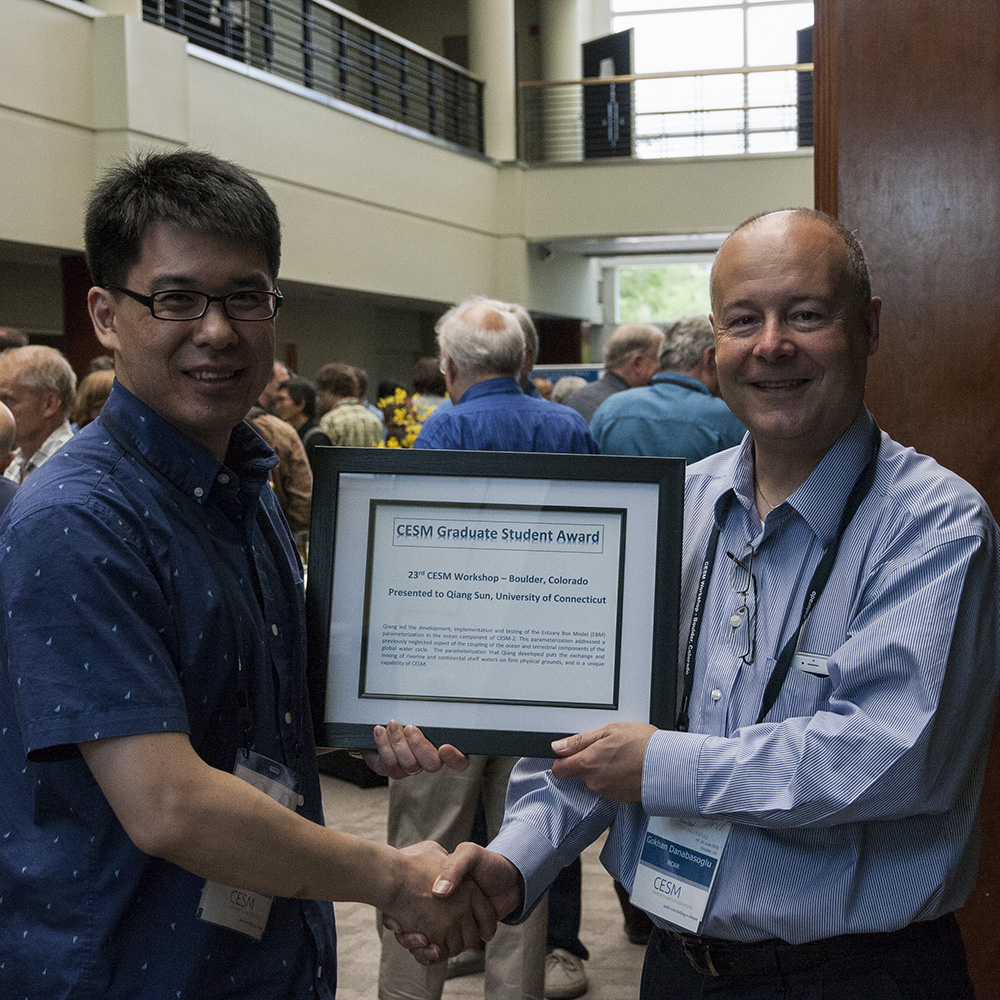2018 CESM Awards
2018 CESM Distinguished Achievement Award - Bill Large

Bill Large and CESM Chief Scientist Gokhan Danabasoglu
Dr. Large played a seminal role in establishing the CESM project and, through his service roles, has figured critically in the project's development into an internationally recognized platform for earth system modelling. His scientific contributions figure prominently in CESM as used today. These include the design and development of the flux coupler and bulk formulae, the development of the K-Profile parameterization for oceanic vertical mixing, and the development of atmospheric data sets for forcing ocean and sea-ice models.
As Head of the Oceanography section (2005-2009), Co-Chair of the Ocean Model Working Group (2002-2008), Director of the Climate and Global Dynamics Division of NCAR (2008-2014), and Associate Director of the NCAR CGD Laboratory (2015-2017), Dr. Large’s leadership has been critical to ensuring that the CESM has obtained the institutional support and funding required for its ongoing development through two CESM generations and the groundwork for the third-generation CESM.
Throughout this extensive service, he constantly worked to ensure effective operation of the project within the complex environment in which it operates, liasing across NCAR CGD, the CESM Scientific Steering Committee, the CESM Advisory Board, and multiple funding agencies. At the same time, he always kept at the forefront the scientific goals of the project, which is reflected in his tireless efforts to address coupled model biases and his many CESM related peer reviewed publications.
2018 CESM Workshop Graduate Student Award - Qiang Sun

Qiang Sun and CESM Chief Scientist Gokhan Danabasoglu
Qiang Sun is a graduate student in the Department of Marine Sciences at the University of Connecticut. Qiang led the development, implementation and testing of the Estuary Box Model (EBM) parameterization in the ocean component of CESM-2. This parameterization addressed a previously neglected aspect of the coupling of the ocean and terrestrial components of the global water cycle. Estuaries are important in the mixing of water properties in the coastal ocean and in setting the stratification in the nearshore environment. From the earliest versions of CSM through CESM-1, this important process was treated in a completely ad hoc manner with an arbitrary specification for the spreading of riverine freshwater to the coastal ocean. The parameterization that Qiang developed puts the exchange and mixing of riverine and continental shelf waters on firm physical grounds, and is a unique capability of CESM. Qiang has a first authored paper describing the formulation and initial testing of the parameterization published in Ocean Modelling (112, 139-157, 2017), and is ready to submit a second paper on further testing and sensitivity studies with the scheme to the JAMES CESM-2 special collection. The later paper also involved construction of a new global ocean coastal hydrographic climatology suitable for evaluating the highly anisotropic and small scales of the coastal salinity distribution. He has presented the work at a number of national meetings including the AGU Fall Meeting and Ocean Sciences, as well as at CESM meetings. In summary, Qiang made a major contribution to CESM-2 that has turned out to be quite successful and impactful, and is deserving of recognition for this accomplishment.
Back to awards page